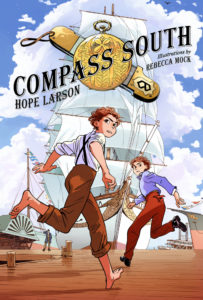Fleen Book Corner: Compass South
It may have been mentioned by somebody in the past forty or so years that one of the great ironies of San Diego Comic Con is you don’t get to read many comics. Thanks to travel before and after, I missed two weeks at the local comic shop, and thanks to the owner having to take a sick day, today will be the first day I’ll get caught up on books since the middle of July. I’m really looking forward to reading Hope Larson’s take on Batgirl (issue #1 released on 27 July), but I’m not been Larsonless in that time.
Because I finally went and picked up a copy of her newest graphic novel (art by Rebecca Mock), Compass South. We spoke about it during our interview in San Diego, where I was particularly struck by the generosity she shows towards her collaborators (which is a recurring theme with Larson; cf: her Twitterfeed today). Unusually for me, this review is mostly spoiler free, as I find myself wanting to talk about some overarching structural choices more than the particulars of the story.
The first book (of two) in the Four Points series (we’ll get Knife’s Edge next June) is a quick, engaging read that left me with a nagging feeling as I read it. Twins — Alex and Cleo — get chased out of 1860 New York, heading for San Francisco; there’s criminal gangs, child-sellers, pirates, tall ships a’sailing, an overland crossing in Panama, a perilous trip ’round the Horn, and a goal of the mythic city of San Francisco. There’s mistaken identities and assumed names and impersonations. There’s blackhearts chasing treasure, evil-minded small men chasing a girl disguised as a boy, and a missing father full of mysteries.
And there was something there at the back of my mind saying You’ve seen this before, but where?
Then it hit me. It’s not that Larson took from any particular story, or any particular genre even (the idea of mid-19th century boys adventure magazines get namechecked, which is particularly frustrating if you’re a girl that doesn’t want to be constrained by gender expectations); it’s that she has tapped into the same themes and tropes that Shakespeare used.
Two sets of twins? Check. Ships in peril and pirates? Check. Missing parents and missing children? Check. Mistaken identities? Check. Everybody meeting up and working out where they were and how they got there? Check. Girls disguised as boys? Check. Shakespeare built his most popular plays — on story cores that had been part of song and myth for millennia. They’ve persisted for so long because they each capture our imagination in particularly strong ways; old Will knew that grabbing one trope was good, but piling on two or three was better, and Larson’s gone further by grabbing four or five.
It’s perhaps inevitable that Compass South would leave me with echoes of The Tempest, The Comedy of Errors, Twelfth Night, and more. In lesser hands, it would come off as derivative or gilding the lily. Here, it’s almost subconscious and makes for a compulsively readable story.
Much has been made of the similarity of comics and movies, but Compass South makes me think that the stage is a better comparison. The stock characters of comics — mysterious playboy/nighttime hero, the youthful ward, the alien with powers beyond those of mortal men, the angsty teen thrust into responsibility — are just as recognizable as the stock characters of the commedia dell’arte — the doomed lovers, the evil prince, the hidden twins, the unscrupulous businessman, the unrepentant villain, and the jolly comic relief — that Shakespeare appropriated and made central to the theatrical world. Larson’s combined the two traditions, and it makes for a cracking story that enriches both¹.
Spam of the day:
New roof! Get work done cheap!
Sorry, just put one in. Had a dumpster in my driveway for two weeks and every damn thing. Also, of all the things to cheap out on, the part of the house that keeps the weather out is probably not the best candidate.
_______________
¹ Or perhaps three traditions — in addition to comics and theater, there’s the literature of the time. More than one character in Compass South is more than a little Dickensian, including a guy who’s very possible Fagin’s second cousin twice removed (in temperament, if not not actual relation). I’m now thinking that maybe why I never cottoned much to Dickens is that he drew from the same tropes as Shakespeare, but trying to express everything solely in words instead of visuals, he becomes bogged down and overly verbose. Now I really want to see what an original graphic novel by Dickens would look like.

The above comments are owned by whoever posted them. The staff of Fleen are not responsible for them in any way.